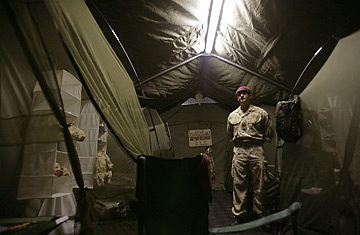
Sergeant Wright of 16 Air Assault Brigade stands in a mock-up of the living quarters of the soldiers serving in the Helmand Province, Afghanistan, at the launch of a new exhbition, "Helmand: The Soldiers' Story" at the National Army Museum in London, 02 August 2007.
In May of last year, the British army deployed 3,300 soldiers to Afghanistan's Helmand province — an arid, mostly desert region in the country's southwest. Tasked to provide security for ongoing NATO reconstruction and humanitarian efforts, they expected little combat. But within weeks the troops were engaged in daily battles with the Taliban and, by the end of their tour in October 2006, had fired 480,000 rounds of ammunition, fought in nearly 500 skirmishes and mourned the loss of 15 comrades.
Now, in "Helmand: The Soldier's Story," an exhibition running at Britain's National Army Museum in London for the next 18 months, troops from the 16 Air Assault Brigade recount their experiences on the frontlines. The exhibit, which may be the first mounted during an ongoing conflict, was curated almost exclusively by the soldiers themselves. "Everything has that real flavor, which you wouldn't get if a production company put it together," says Major Alex Parks, a soldier-cum-curator who ran operations in Helmand.
Video and audio testimonials drive the exhibition, offering raw and disturbing accounts of combat. In one video clip, a soldier describes the emotional aftermath of a soldier's death in a roadside accident: "The worst part was the coffin." In another, soldiers launch a rocket and laugh as a building collapses. "No one is coming out of that alive, are they?" one of them asks.
The audio reels are as compelling. Warrant Officer Andrew Stockton relives the moment his arm was blown off by a grenade: "I reached up to my arm which I knew had been hit — it felt like I'd been hit with a sledgehammer. There was no massive pain, it was just numb. It felt like raw steak, to be honest. So I grabbed hold of the artery that runs underneath and just pinched it as hard as I could." The shrapnel removed from Stockton's arm is on display. It still contains pieces of his uniform.
The show does more than highlight the horrors of war: it also captures the minutiae of daily life. A claustrophobic tent reconstructs the unit's sleeping quarters, replete with its mosquito nets, toiletries, uncomfortable cots, a portable shower and the overbearing scent of plastic sheets. Scattered across the room are letters and personal paraphernalia, donated by more than 150 soldiers.
While periods of combat were both intense and harrowing, the soldier's downtime could be incredibly mundane. In one photomontage, accompanied by narration, soldiers describe how they passed their time. Besides listening to their iPods and playing video games and Sudoku, they scheduled four-day bow and arrow competitions using tin cans and wooden posts as targets, with the winner receiving a bag of potato chips. Tired of eating their 4,000-calorie ration boxes that contained dried foodstuffs and chocolate, the soldiers express joy when friendly locals provide Afghan bread, onion and chilies.
The exhibit attracted more than 10,000 visitors in its first three weeks — and perhaps as many reactions. A video projection — which features footage of soldiers storming compounds and firing machine guns, all set to the sounds of Metallica's "Enter Sandman" and the Cranberries' "Zombie" — drew particularly strong criticism. "The rock music played against the film strip made it seem like a commercial," one visitor wrote on the show's uncensored message board. Sundry messages crowd the board, coming from school children, war protesters, former soldiers and friends and family of the troops.
And while it's a testament to the show that it fuels strong feedback, its biggest achievement may be that it compels people to ask questions not just about the exhibition, but the war itself. As another message reads: "My heart bleeds for these young soldiers. So brave, but fighting for what?"
